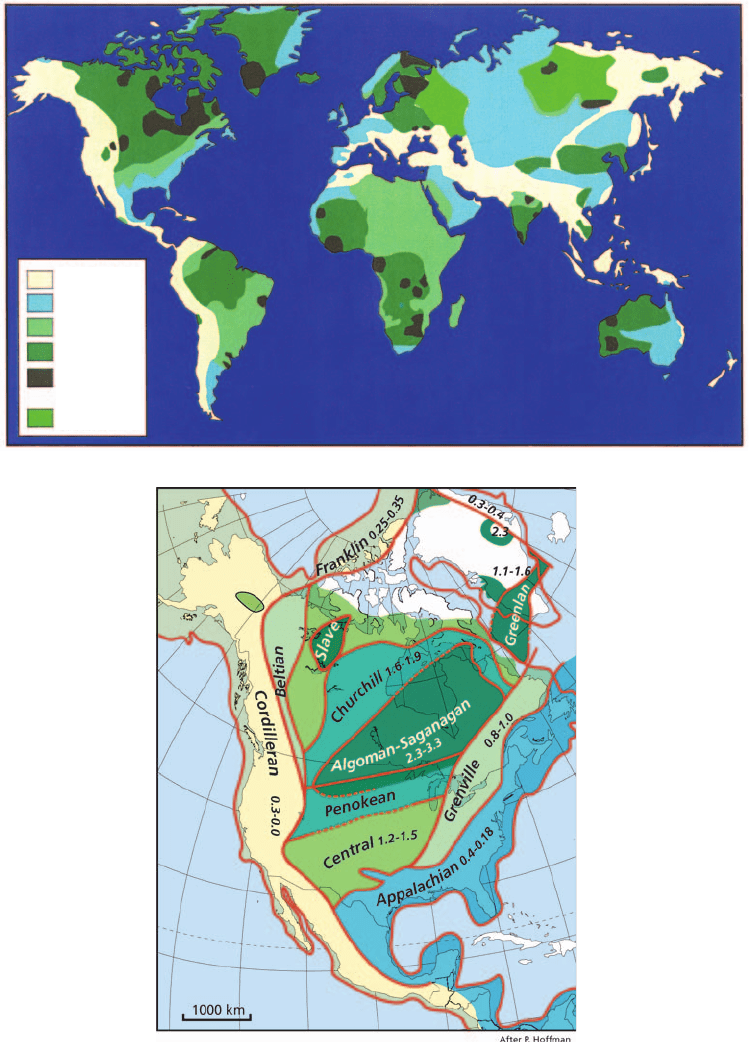All?gre Claude J. Isotope Geology
Подождите немного. Документ загружается.


bombarding 1 mg of carbon with a stream of cesium ions, the flow of
14
C
þ
ions is 15
ions per second.
(a) For the same intensity of current of
12
C, how many
14
C ions are obtained per unit
time for 1 mg of carbon aged 55 ka?
(b) If the measurement lasts 20 minutes, what is the uncertainty on the age determina-
tion? Compare it with the error on the measurement of the present-day
14
C/
12
Cratio.
(c) What is the minimum age we can hope to measure in the same conditions if we
decide the difference to be measured with the present day must be at least five
times greater than the uncertainty?
(d) If we wanted to make the same measurement by counting radioactivity and the
maximum counting time for a sample was 8 days, how much carbon would need to
be purified?
(ii) We wish to use the
238
U–
230
Th method to test the
14
C age of corals assumed to be about
55 000 years old. To simplify, we ignore the
234
U/
238
U fractionation and assume that
(
230
Th)
0
¼0. The dating equation is written:
230
Th
232
Th
¼
238
U
232
Th
ð1 e
l
230
t
Þ:
Given that the uncertainty on the
230
Th/
232
Th ratio measurement is 1% and that the uncer-
tainty on the
232
Th and
238
U measurements is about 5ø, what is the uncertainty on the age?
Is this a good method for checking the results obtained by
14
C in this age range?
5 We are confronted with the geological situation shown in the section in Figure 5.38.
A geological formation of foliated and folded gneiss is cross-cut by a granodiorite which is
itself foliated.
(i) We wish to measure the age of the gneiss and to do so we make a series of
87
Rb/
86
Sr
measurements on the whole-rock. The results are given in Table 5.9. The Sr concentrations
of the various facies are very similar. Calculate the
87
Rb/
87
Sr age using a simple least-
squares method (without experimental uncertainties).
(ii) We determine the age of the granite by U–Pb methods applied to zircons from the granite.
Table 5.10 shows the results. Calculate the U–Pb age again by the simple least-squares
method and the concordia method. How would you interpret the result in geological
terms? Can you give a brief geological history of the region?
87
Rb-
87
Sr
(Whole rock)
U-Pb
(Zircons)
Figure 5.38 Geological formation of gneiss cross-cut by granodiorite.
217 Problems

6 A granite from south-eastern Canada is dated by various methods. The apparent age
results are:
Can you reconstruct the geological history of this granite and explain the ages measured?
7 We can determine the Permian–Triassic boundary at a given location. A granite cross-cutting
the Permian formation but with pebbles at the base of the Triassic is dated 243 5 Ma. The
Triassic is dated by two basalt flows located in a section 100 m above the Permian–Triassic
boundary at 229 8 Ma and another 200 m above the Permian–Triassic boundary at
215 3 Ma. What is the approximate age of the Permian–Triassic boundary? What is the
error on the age determination at 218 3 Ma?
8 You are asked to explore the possibility of using the U–He chronometer.
(i) What time-span do you think best corresponds to the potential of the method?
(ii) What types of rock or mineral do you think are interesting a priori?
9 Half a century ago the question of the origin of granite was a subject of much debate. The
American Bowen showed by laboratory experiment around 1930 that rock of granitic com-
position could be made from basaltic magma (which we know is itself the product of partial
melting of the mantle). Bowen and Winkler in Germany showed, again by experiment, that
the melting of detrital sediments (shales and sandstones) to which sodium has been added
Table 5.9 Samples from the gneiss in Figure 5.38
Sample
87
Sr/
86
Sr
87
Rb/
86
Sr
1 0.713 0.0005 0.1 0.0005
2 0.718 0.0005 0.35 0.0005
3 0.719 0.0005 0.45 0.0005
4 0.722 0.0005 0.6 0.0005
5 0.724 0.0005 0.8 0.0005
6 0.723 0.0005 0.9 0.0005
Table 5.10 Samples from the granite in Figure 5.38
Sample
206
U*/
238
U
207
Pb*/
235
U
A 0.3 0.01 5 0.3
B 0.26 0.01 4 0.3
C 0.24 0.01 3.5 0.3
D 0.2 0.01 2.5 0.3
Method U–Pb
concordia
Rb–Sr
whole
rock
Sm–Nd
whole
rock
Rb–Sr on
biotite
39
Ar–
40
Ar Rb–Sr on
muscovite
Apparent
age (Ga)
2.8 0.1 2.7 0.1 2.7 0.1 1.7 0.2 1 0.1 1.7 0.2
218 Uncertainties and results of radiometric dating

also gives rise to a granitic magma. Subsequently, other experiments showed that the partial
melting of ‘‘wet’’ basalts produced granitic fluids.
These experimental data were supplemented by field observations and then more recently
by
87
Sr/
86
Sr measurements supporting the idea that almost all continental granites result
from the remelting of continental crust. The model of granites derived directly from the
mantle was abandoned. Yet, in the middle of the mid-Atlantic ridge, in Iceland, the famous
Hekla volcano has spewed out lava of granitic composition (rhyolites). The
87
Sr/
86
Sr ratios of
about 0.7032 give no clear answer to their origin as they are similar to those of many basaltic
lavas of Iceland.
The Icelander Sigmarsson studied the (
230
Th/
232
Th,
238
U/
232
Th) ratios of these rhyolites
with the
230
Th–
238
U isochron diagram. The mantle beneath Iceland is in secular equilibrium,
corresponding to
238
U/
232
Th ratios of 1.1 to 1.3 (in activity). The oldest basalt crust of Iceland
has (active)
238
U/
232
Th ratios ranging from 0.9 to 1.1. It too is in secular equilibrium. The
rhyolites have a
230
Th/
232
Th ratio of 0.95 and
238
U/
232
Th of about 0.8. What do you think is
the origin of this rhyolite?
10 Calculate the range of application of the
238
U–
206
Pb dating method for rocks and minerals
with the chemical ratios shown in the table below, given that the isotopic measurement is
affected by several relative uncertainties
x
of 10
3
,10
4
, and 10
5
.
Draw the graphs corresponding to Figure 5.35. Calculate for the Rb/Sr ratio, and for U–Pb
applied to whole rocks and the main minerals that can be dated by this method.
Type of rock or
mineral
Granite Basalt Ultramafic Zircon Sphene
U/Pb 0.2 0.1 0.05 100–10 2
219 Problems

CHAPTER SIX
Radiogenic isotope geochemistry
Our main concern in the previous chapters has been to calculate geological (or cosmo-
logical) ages and to clarify their geological meanings. In the next chapters we are going to
address isotope geochemist ry, which has a markedly di¡erent viewpoint although it is
based on the same physical laws and on the s ame equations.We are going to look not at age
but at the isotope ratios measured and the ways in which their natural variations may be
inter prete d.
This chapter, then, focuses on isotope ratioswhosevariationsarise m ainlyfrom radioac-
tive decay. Chapter 7 will be aboutisotopevariations caused by physical and chemical pro-
cesses. Examination of the variations in isotopic ratios will lead us to develop a
methodologyinwhichtheseratios areusedas tracersfor majorgeological andgeodynamic
phenomena. The purpose of these studies is therefore to determine the major structures
and exchanges of matteroccurring (or having occurred) among the major terrestrial reser-
voirs (crust, mantle, core, and atmosphere). The notion of age will crop up again, but in a
much moregeneral context, although in complete conti nuity withthe earlierchapters.
6.1 Strontium isotope geochemistry
6.1.1 Continents and oceans: granite and basalt
The natural isotopic composition ofstrontiumvaries with
87
Rb d ecay. Systematic collation
of
87
Sr/
86
Sr isotope compositions ofterrestrial basalt and granite (basaltbeing an isotopic
‘‘messenger’’fromthe mantle while graniteis a sample ofcontinental crust) revealsverydif-
ferent distributions. Strontium isotope ratios for granites from the various continents are
highly variable, ranging from 0.705 to 0.850 and more. Strontium isotope ratios for basalts
are much more uniform.They rangefro m 0.7020 to 0.7070 and foroceanic basalts from just
0.7022 to 0.7045.
Let us get these orders of magnitude clear. ‘‘Ordinary’’ analytical precision on the
87
Sr/
86
Sr isotope ratio is at least1.5 10
4
(relative) and therefore, on ratios close to 0.7, the
u ncertainty isbetter than10
4
(absolute).This means that0.7022 canbe distinguished from
0.7021 for certain. For granite, variations range from 0.850 to 0.705, corresponding to1500
measurement units. Foroceanic basalts, the range is 25 measurement units, or a dispersion
ratio of 60 timeslessthan forg ranites.
This di¡erence in the distributions of strontium isotope ratios between continents and
mantle can be explain ed by th e geological history of the two reservoirs from which granite

Plate 1 Periodic table of the elements. The isotopes most commonly used in isotope geology are indicated.

Magnet
Magnet
Multicollector
Multicollector
Ion
beams
Ion
beams
Electrostatic
analyzer
Multi-filament
turret
Plasma
generator
Source
Plate 2 Modern mass spectrometers. In each case, the mechanical components are shown at the top and the ion
beam pathways below. Top: TIMS (thermal-ionization mass spectrometry). At the source, a turret allows several
samples to be tested in succession; at the collector, multicollection allows the various beams from different
isotopes to be analyzed without scanning. Bottom: ICPMS (inductively coupled plasma mass spectrometry). In
addition to the magnet, an electrostatic analysis sorts the ions by energy levels. The source is a plasma generator.
Multicollection is used as in TIMS.

Plate 3 Actual laboratory equipment. Top: A Cameca ion probe. Bottom: A clean room where samples
are prepared.

60
90 180
120 60
90 0
60
0
6060
0
Dark red 0-1 Ma
Medium red 1-4 Ma
Light red 4-9 Ma
Orange 9-20 Ma
Brown 20-35 Ma
Light brown 35-52 Ma
Yellow 52-65 Ma
Green-yellow 65-80 Ma
Light green 80-95 Ma
Medium green 95-110 Ma
Dark green 110-125 Ma
Green-blue 125-140 Ma
Blue 140-160 Ma
Purple 160-180 Ma
Plate 4 Map of ocean floor ages. After Sclater, Jaupart, and Garlson (1980).

0.25 - 0 Ga
0.7 - 0.25 Ga
1.7 - 0.7 Ga
2.5 - 1.7 Ga
3.8 - 2.5 Ga
3.8 - 1.7 Ga
Plate 5 Map of age provinces of continents. Top: world map. Bottom: more detailed map of North
America. After Hofmann (personal communication, modified).

3.8
3.6
3.2
2.8
Present day
Formation
of the Earth
Hadean
Archean
Isua formation
Greenland
Barberton
Great Canadian
orogeny
Cambrian
8
Ga
Phanerozoic time
West-African
orogeny
Proterozoic
Grenville
orogeny
Pan-African
orogeny
Eoarchean
Paleoarchean
Mesoarchean
Neoarchan
4.0
4.5
2.5
1.6
1.0
0.55
Paleoproterozoic
Mesoproterozoic
Neoproterozoic
Ga
Big Bang
Precambrian times
12
Ga
10
Ga
Plate 6 Geological timescales. Left: Precambrian times. Right: Phanerozoic times.
